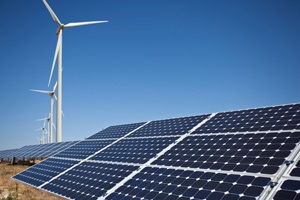Just because it’s windy or sunny, doesn’t mean it’s the best place for turbines or PV
 New research from Carnegie Mellon University suggests that the best places for renewable energy like wind and solar in the U.S.—and around the world, for that matter are places where the grid is largely powered by coal-fired power plants. The report, recently published in "Proceedings of the National Academy of Science" contends that the greatest benefits of renewable energy like wind and solar stem from the reduction of carbon dioxide and other pollution as opposed to their capacity for endless yet somewhat intermittent energy without a fuel source.
New research from Carnegie Mellon University suggests that the best places for renewable energy like wind and solar in the U.S.—and around the world, for that matter are places where the grid is largely powered by coal-fired power plants. The report, recently published in "Proceedings of the National Academy of Science" contends that the greatest benefits of renewable energy like wind and solar stem from the reduction of carbon dioxide and other pollution as opposed to their capacity for endless yet somewhat intermittent energy without a fuel source.
As such the paper contended that the places where solar and wind are most valuable are in more easterly states. "The main reason to build wind and solar plants is to reduce air pollution and carbon dioxide emissions, therefore the Southwest and California are about the last place in the U.S. where plants should be built. Building new wind and solar plants in Ohio, West Virginia and western Pennsylvania is a much better bet," according to the university.
In "Regional Variations in the Health, Environment and Climate Benefits of Wind and Solar Generation," by Carnegie Mellon’s Kyle Siler-Evans, Ines Lima Azevedo, M. Granger Morgan and Jay Apt, the authors (all part of Carnegie Mellon’s cross-disciplinary Center for Climate and Energy Decision Making) contended that solar and wind in the previously mentioned region could replace coal generation and add much more overall value than in places like California or even in Iowa, where wind reigns supreme.
"A wind turbine in West Virginia displaces twice as much carbon dioxide and seven times as much health damage as the same turbine in California," said Siler-Evans, a Ph.D. researcher in CMU's Department of Engineering and Public Policy from Santa Fe, N.M. "The benefits of solar plants are greatest in the cloudy East as opposed to the sunny Southwest."
"While there is of course some uncertainty about the magnitude of the health and environmental damages avoided, if we are going to justify the added cost of wind and solar on the basis of the health and climate benefits that they bring, it is time to think about a subsidy program that encourages operators to build plants in places where they will yield the most health and climate benefits," said co-author Azevedo.
However, solar and wind growth have been greatest in Southwest and even the midwest, thanks largely to higher amounts of sun and wind. Federal subsidies are the same across the country, but because of state subsidies, solar has taken off in markets like California, much more so than in West Virginia.




